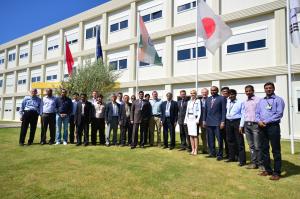Cooling water: last preliminary design review
15 Jun 2012
-
Steve Ployhar, ITER Technical Responsible Officer
Cooling water experts gathered this week in Cadarache, including Warren Curd (first from left), Sekhar Basu (ninth from right), Prashant Wani (fourth from right), and Indian and ITER technical responsible officers Dinesh Gupta and Steve Ployhar (fifth from left, sixth from right).
Nearly all of the heat generated during ITER operation, whether it be from the fusion reaction, auxiliary systems, electrical cabinets, (or even warm bodies!) will be collected by the component cooling water system (CCWS) or the chilled water system (CHWS). These systems subsequently reject the heat to the atmosphere, either directly or via ITER's heat rejection system (HRS).
Although the CCWS and CHWS systems use standard, proven technology, the design of the systems is highly complex. The systems will serve a wide variety of clients, all with different requirements and with designs at different levels of maturity. Approximately 200 unique interface documents are required to define the CCWS and CHWS interfaces with clients, buildings, and services.
The design and procurement of these systems is under the responsibility of the Indian Domestic Agency. On 11-14 June, the preliminary design review for the CCWS and CHWS cooling water systems was held in Cadarache, gathering representatives from the ITER Organization, the Indian Domestic Agency, and experts in the field. One of the experts was Warren Curd, former ITER Cooling Water Section leader, who travelled from China where he is currently a construction coordinator for two of the first Westinghouse AP1000 reactors to be built.
Sekhar Basu, chief executive at the Department of Atomic Energy in India, was chairman of the Design Review. During a meeting of the review panel on the final day, he received a phone call informing him that he had just been appointed Director of the Bhabha Atomic Research Centre (BARC), India's premier nuclear research facility based in Mumbai. This announcement was greeted with a spontaneous round of applause and congratulations from the panel members.
One of the important topics discussed during the review was the approach taken to seismic design of the system piping that will crisscross the site and be installed in nearly every building. "While the analytical approach we took was satisfactory, this meeting gave participants the opportunity to ensure agreement on assumptions and inputs so that safety, regulatory, and investment protection goals are met," says Prashant Wani, project engineer for Tata Consulting Engineers, who performed preliminary design on behalf of the Indian Domestic Agency.
A few other key issues, inherent to this stage of design, were identified during the review. Following the resolution of these issues and one last review of interfaces, the next step will be for ITER-India to launch a call for tender to select an engineering and procurement contractor to perform final design and procurement of piping and equipment.
The first shipment of piping is due on site in the summer of 2014.
The preliminary design review of the tokamak cooling water system (TCWS) and the heat rejection system (HRS) took place in March 2012.


